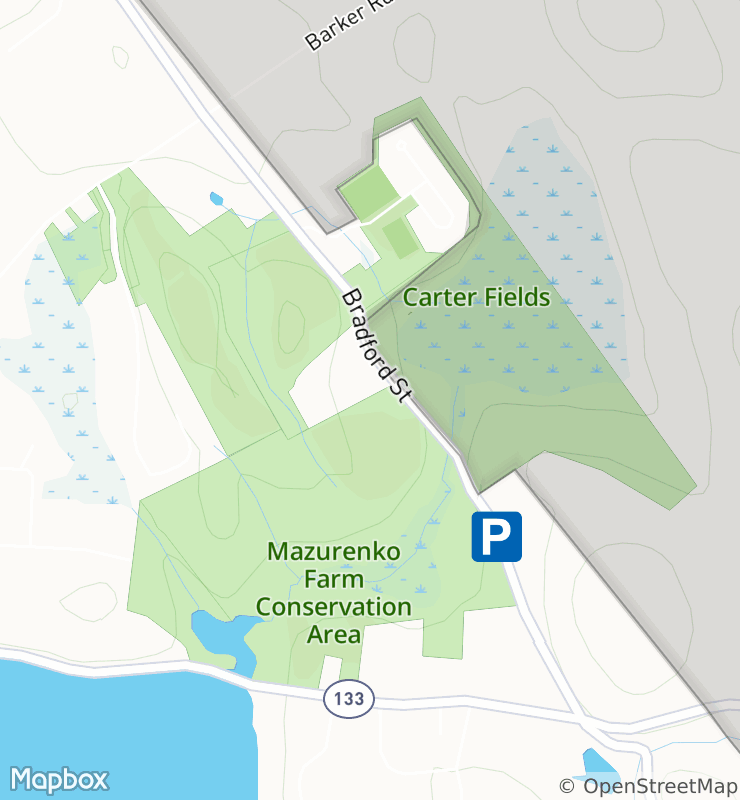MAZURENKO FARM & CARTER HILL
Centered around peaceful Bradford St, this collection of woodlands, wetlands and farm fields includes a heron rookery and one of the last undeveloped drumlin vistas in town.
TRAILS
LOCUST TRAIL The trail begins at the trail kiosk and stone steps at the Mazurenko Farm parking lot. The wetland crossing may flood in springtime. Be mindful of poison ivy growing along the trail edge.
SCOUT TRAIL After crossing the wetland area on the Locust Trail, turn left onto this trail to follow along the edge of the flooded meadow to Rea’s Pond. A steep connector trail heads up the hill to the Ridge Trail.
REA’S POND TRAIL A tranquil spot near the road, with a bench on the shore of the pond. It is ringed with trees which blaze with color in autumn. The trail soon forks left for the Ridge Trail and right for the Scout Trail.
RIDGE TRAIL One of the longer trails, it climbs the hill behind Rea’s Pond and traverses the ridge from a pine grove to open fields at the other end, where it meets the Locust Trail.
CARTER HILL VISTA LOOP TRAIL The trail is through open fields. Park at the Carter Hill Lot and proceed up the hill. The climb to the top of the hill is worth the effort. The view is of forest and farm fields. This trail is swallowed by tall grass at times, but Carter Hill can still be explored. The hill is also used for sledding.
HIGHLAND TRAIL Pick up this trail at the far corner of the Carter Hill field. After a short distance, you’ll emerge at another farm field. Proceed along the edge of the field to the nearest corner, where a woodland trail will connect with the Ridge Trail.
If you have extra time, visit Carter Fields, across Bradford St.
HISTORY
Purchased in 1975, Rea’s Pond was the first parcel of land to be acquired by the town for conservation and watershed protection. Two sites here are believed to have been occupied between 2,500 and 6,000 years ago. Artifacts are presently at the Buttonwoods Museum in Haverhill.
The Mazurenko Farm area was farmed from early times first by the Tyler Family, and during the 19th century by the Barker and Rea families. In the 1930s, the Mazurenko family, originally from Ukraine, bought the farm where they raised cattle, pigs, corn and hay. There was a small apple orchard as well. The abandoned farmhouse burned in 1986. In 1988, the town purchased the land for a recreation area and to protect the Lake Cochichewick watershed.
Carter Hill was acquired from George Barker and the Carter family in 2001, funded in part with Community Preservation Act funds.
FLORA AND FAUNA
The Locust Trail is named for the locust tree. Look for a small grove of them as you leave the parking lot. Other trees to watch for are silver birch and river birch along Rea’s Pond, and large ash and white pine on the Ridge Trail. Look for trees felled by beavers on the northern side of Rea’s Pond.
Throughout Mazurenko Farm, you’ll see many trees constricted by large vines. These are invasive oriental bittersweet vines, which can kill trees by smothering and eventually pulling down their crowns with the sheer weight of bittersweet vines and leaves.
The wet crossing on the Locust Trail is a great spot to get up close to native wetland species such as Joe-Pye weed and cattails.
On a recent afternoon in May, birdwatchers reported sighting song sparrow, warbling vireo, common yellow throat, great blue heron, tree swallow, mallard, red-winged blackbird, northern flicker, brown-headed cowbird, Baltimore oriole, bobolink, turkey vulture, downy woodpecker, red-bellied woodpecker, rose-breasted grosbeak, yellow warbler and a catbird.



